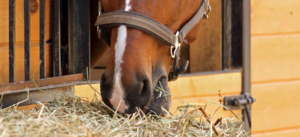 Common hays fed to horses include various pure grass hays, mixed grass hays, and legume hays such as alfalfa (lucerne) and clover. If these hays are not available, horse owners may have to choose alternative hays from less traditional hay types. While these other forages are usually suitable for horses, some have associated risks.
Common hays fed to horses include various pure grass hays, mixed grass hays, and legume hays such as alfalfa (lucerne) and clover. If these hays are not available, horse owners may have to choose alternative hays from less traditional hay types. While these other forages are usually suitable for horses, some have associated risks.
Foxtail or German millet can be used for horse forage. If foxtail millet hay is fed to horses, additional calcium supplementation will be required as it is high in oxalates, substances that make it difficult for the horse to absorb the calcium in its diet. Some reports show that horses grazing millet hay may have lameness and joint swelling. Some pearl millet reportedly has an alkaloid buildup that can induce toxicity in cattle. Horses may also react to these alkaloids because they are susceptible to alkaloid toxicity syndromes. All millets can accumulate nitrates, which in grazing or haying millets can reach toxic proportions. Nitrate can be controlled somewhat by reducing the amount of nitrogen per application and increasing the number of applications. German millet can cause oral lesions.
Sorghum grasses include sudangrass, johnsongrass, hybrid forage sorghums, and grain sorghums. Here we consider all classes of forage sudangrasses and associated hybrids the same. In reality, there may be some without toxicity problems.
Sudangrass in the green growth stages can cause a urinary tract disease in horses called cystitis syndrome or cystitis/ataxia (staggering). The disease is irreversible and is believed to be associated with low levels of cyanide (prussic acid) in sudangrass. Piper sudangrass is a variety low in prussic acid and may be a good choice to minimize this problem. Hay produced from sudangrasses will not likely cause cystitis/ataxia syndrome because prussic acid dissipates as hay cures. Sorghum pasture can also cause a problem for pregnant mares in the first three months of pregnancy, presumably because of prussic acid content; mares may abort. Foals can be born with contracted tendons.
Sweet-stemmed sudangrasses and other sorghums that are relatively high in sugar also cause a laxative reaction in horses. If it is necessary to use sudangrasses, be sure to use a nonsweet, starchy type and try to use other roughages as part of the ration.
Like sudangrass, johnsongrass can be high in prussic acid (cyanide), which can occur in any green plant and especially stressed ones. Rapid growth after a drought, plants stressed by drought or cold, and plants at and soon after frost are especially hazardous. Prussic acid does not occur in dangerous amounts in properly cured, dry hay. Prussic acid poisoning is not as severe a problem in horses as in cattle, but it can occur. Johnsongrass can also have a high nitrate content.
All types of sorghum contain cyanogenic glycosides, although there is quite a bit of variation among species and varieties. Some types of sorghum have been associated with poisoning horses in Australia. If horses are grazing sorghum-dominant pastures or if they are fed hay containing sorghum species, they may have an increased risk of chronic cyanide poisoning. A higher risk is associated with grazing young sorghum-dominant pastures affected by frost or storms and sorghum hay that has not been cured. The risk of poisoning is generally associated with accumulation of toxic levels of cyanogenic glycosides, resulting in chronic neurotoxicosis.
Pea straw has low digestibility and quality, but would be usable provided it is mixed up to 50:50 with a good-quality grass hay or legume hay.
Barley hay is suitable as an alternative forage for horses. The average analysis of barley hay shows a relatively low level of energy and protein, with similar calcium and phosphorus values as oaten hay. Try to select barley hay that has been cut at the milky dough stage, so the grain and the barley awns are not fully developed. When feeding barley hay, be aware that awns from the heads may catch in a horse’s teeth or cause ulcers in the horse’s mouth. This means that you should only feed green, immature barley hay as the awns haven’t had the chance to dry and become hardened. While oaten hay can be quite golden, barley hay should be green. Oaten hay is considered to be more palatable than barley hay and is probably the first choice for this reason, but barley hay can be a useful hay when a horse doesn’t need the extra energy and protein in alfalfa (lucerne) and a grass hay is needed.
Canola hay is not recommended as it has low digestibility and questionable quality and usually is treated with a heavy spray that the horses will ingest. Triticale and wheaten hays are usually acceptable provided they are cut early and do not have an abundance of awns or grain in the heads. Vetch hay, a legume, is also an acceptable forage.
Would you like help evaluating your horse’s diet? Contact us at J & J Farms by clicking here!
Article brought to you by KER.
